The journey to raising a happy, healthy child is an endeavor that every parent cherishes. One key aspect of your child’s well-being is a strong and robust immune system, and probiotics play a vital role in achieving this goal. Probiotic-rich foods are not just nutritional powerhouses; they also aid in maintaining a balanced gut flora, bolstering immunity, and promoting overall health. However, getting your child to embrace these foods can sometimes be a challenge.
In this blog, we unveil “10 Effective Tips to Get Your Child Hooked on Probiotic-Rich Foods.” From the magic of yogurt to the allure of fermented foods, we’ll explore creative and practical ways to incorporate these nutritional heroes into your child’s diet. Your child’s journey to optimal health begins here, where probiotics become their newfound favorites, and you, the parent, become the guiding star.
Table of Contents
ToggleWhy Probiotic-Rich Foods are Important for Children
Probiotic-rich foods have garnered attention for their remarkable health benefits, and they play an equally essential role in the well-being of children. Probiotics, often referred to as “good” or “friendly” bacteria, are live microorganisms that provide a myriad of advantages for your child’s developing body and overall health. Here’s why they are crucial:
- Gut Health: Probiotics contribute to a balanced gut microbiome. A healthy gut is linked to improved digestion, nutrient absorption, and a strengthened immune system.
- Immune Boost: A significant portion of the immune system resides in the gut. Probiotics help fortify the immune response, making children less susceptible to illnesses.
- Digestive Comfort: Probiotics can alleviate common digestive issues in children, such as constipation, diarrhea, and irritable bowel syndrome.
- Allergy Prevention: Some probiotics have shown promise in reducing the risk of allergies and atopic conditions in children.
- Mood and Behavior: Emerging research suggests that gut health influences mood and behavior, potentially affecting a child’s emotional well-being.
- Nutrient Absorption: Probiotics aid in the absorption of essential nutrients, promoting healthy growth and development.
For More- Should We Worry About Food Additives?
Tips to Encourage Your Child to Eat Probiotic-Rich Foods

This article provides practical tips to encourage your little ones to enjoy fermented vegetables, yogurt, kefir, and other gut-friendly treats.
1. Start Early and Lead by Example
Start Early and Lead by Example: Begin introducing probiotic-rich foods to your child’s diet from an early age. Offer small portions of yogurt, kefir, or other fermented foods, and make it a regular part of their meals. Children often mimic what they see, so lead by example. Enjoy these foods yourself, and demonstrate that they are delicious and enjoyable.
When children see their parents or caregivers embracing probiotic-rich foods, they are more likely to develop a taste for them and continue to include them in their diet as they grow. Starting early and setting a positive example can pave the way for a lifetime of good gut health and overall well-being.
2. Make It Fun with Shapes and Colors
Make It Fun with Shapes and Colors: Children are naturally drawn to visually appealing foods. Transform probiotic-rich options into a fun and enticing experience by creating colorful and playful presentations. Use vibrant fruits or berries to add a pop of color to yogurt or make kefir smoothies with a variety of flavors.
Experiment with different molds to shape fermented foods into exciting forms, like star-shaped cheese slices or heart-shaped probiotic-rich gummies. By making probiotics visually stimulating, you not only capture your child’s attention but also make the consumption of these healthy foods an enjoyable adventure.
3. Involve Them in the Kitchen
Involve Them in the Kitchen: Encourage your child’s curiosity and interest in probiotic-rich foods by involving them in the kitchen. Let them take part in simple food preparation tasks, such as mixing yogurt with fresh fruit or helping to create their own custom yogurt parfait.
When children actively participate in the cooking process, they develop a sense of ownership and excitement about what they’re eating. This hands-on approach fosters a positive relationship with probiotic-rich foods and empowers them to make healthier food choices in the future. Plus, it’s an excellent bonding opportunity for you and your child as you explore the world of culinary creativity together.
4. Create Probiotic-Rich Snacks

Create Probiotic-Rich Snacks: Snacking is a big part of a child’s diet, so take advantage of this by crafting probiotic-rich snacks. Transform plain yogurt into a tasty treat by mixing it with honey and fresh fruit, or freeze yogurt to create delightful probiotic popsicles. Experiment with homemade probiotic-rich dips for vegetable sticks or whole-grain crackers.
These snacks not only provide essential nutrients but also make probiotics easily accessible throughout the day. When healthy options are readily available, your child is more likely to reach for these delicious and nutritious choices.
5. Blend Probiotic-Rich Foods into Smoothies
Blend Probiotic-Rich Foods into Smoothies: Smoothies are a fantastic way to introduce probiotic-rich foods to your child’s diet. Mix yogurt, kefir, or fermented fruits into delicious and colorful smoothie creations. Add a handful of fresh or frozen berries, a banana, and a splash of honey for sweetness.
Don't just scroll, subscribe!
BuzzTrail's unique web-stories are the cure for boredom you've been waiting for.
These creamy concoctions offer a refreshing and tasty approach to deliver probiotics while disguising any potential tangy taste. Smoothies are not only a hit with kids but also provide a versatile canvas for creativity in the kitchen. Experiment with different flavor combinations and let your child be part of the smoothie-making process to spark their excitement about these healthy treats.
6. Organize Probiotic Taste Tests
Organize Probiotic Taste Tests: Turn trying probiotic-rich foods into a fun and engaging activity for your child by organizing taste tests. Set up a “probiotic buffet” with a variety of options like different yogurt brands, flavors, and types of fermented foods. Encourage your child to taste and compare them, sharing their thoughts on what they like best.
This interactive experience not only allows them to choose their preferred probiotic sources but also fosters a sense of involvement and exploration in their own health. As they discover their favorites, it becomes a joyful journey rather than a challenge, making probiotics an integral part of their diet.
7. Incorporate Probiotics into Favorite Dishes
Incorporate Probiotics into Favorite Dishes: A seamless way to introduce probiotic-rich foods is by incorporating them into your child’s favorite dishes. Add yogurt or kefir as a topping on pancakes, waffles, or cereal for a creamy twist. Use fermented vegetables like kimchi or sauerkraut as flavorful additions to sandwiches or wraps.
These subtle introductions of probiotics into beloved meals allow your child to enjoy their favorite foods while reaping the health benefits of probiotics. It’s a win-win situation that ensures they get the nutrition they need without feeling like they’re making major dietary changes.
8. Storytelling about “Gut Heroes”
Storytelling about “Gut Heroes”: Create an enchanting narrative around probiotic-rich foods, turning them into “Gut Heroes” embarking on epic adventures inside your child’s tummy. Describe how these tiny champions protect against sneaky invaders, boost the immune system, and maintain harmony within.
By weaving this imaginative tale, you make probiotics come to life for your child, instilling the idea that they are essential allies in the quest for good health. This storytelling approach can spark your child’s fascination and curiosity, making them more receptive to the idea of incorporating probiotics into their diet.
9. Praise and Positive Reinforcement
Praise and Positive Reinforcement: When your child embraces probiotic-rich foods, celebrate their choices with praise and positive reinforcement. Compliment their willingness to try new foods and express how proud you are of their healthy eating habits. Use positive words to describe the benefits of probiotics and how they contribute to their well-being. Reinforce the idea that making smart food choices makes them strong and resilient.
This encouragement fosters a positive association with probiotic-rich foods, reinforcing the notion that these choices are not only good for their health but also worthy of recognition. By creating a positive environment around probiotics, you motivate your child to continue making these healthy selections.
10. Be Patient and Persistent
Be Patient and Persistent: Introducing probiotic-rich foods to your child’s diet can be a gradual process. Some children may take to them immediately, while others might need time to adjust. Patience is key. Keep offering probiotics, even if your child initially refuses or shows reluctance. Continue to incorporate these foods in various forms, and don’t be discouraged by temporary setbacks.
Persistence, combined with a patient and understanding approach, will eventually lead to acceptance. Remember that every child is unique, and it may take time for their taste preferences to adapt. Stay committed to nurturing their gut health, and over time, they are likely to develop a liking for probiotic-rich options.
Also Read- The World’s Six Hottest Peppers
Conclusion
Ensuring your child consumes probiotic-rich foods is a wonderful way to support their overall health and well-being. By incorporating these tips into your mealtime routine, you can make the process enjoyable and engaging for your little one. Remember to start early, involve them in the kitchen, and get creative with the presentation. Whether it’s through playful shapes, delicious smoothies, or incorporating probiotics into their favorite dishes, you can foster a love for gut-friendly foods that will last a lifetime.
So, let’s embark on this probiotic adventure together, and watch your child happily embrace these nutritious and tasty delights.
FAQs
What are probiotics, and why are they important for children?
What are probiotics, and why are they important for children?
Provide an overview of what probiotics are and their specific benefits for children’s health and well-being.
Which foods are rich in probiotics, and how can I incorporate them into my child’s diet?
Which foods are rich in probiotics, and how can I incorporate them into my child’s diet?
Explain the different sources of probiotics, such as yogurt, kefir, and fermented foods, and offer practical tips on including them in your child’s meals.
Are probiotic supplements a good option for children, and how do I choose the right one?
Are probiotic supplements a good option for children, and how do I choose the right one?
Discuss the pros and cons of probiotic supplements for kids and provide guidance on selecting the most suitable supplement if needed.

